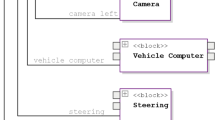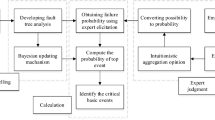Abstract
In protection systems, when traditional technology is replaced by software, the functionality and complexity of the system is likely to increase. The quantitative evidence normally provided for safety certification of traditional systems cannot be relied upon in software-based systems. Instead there is a need to provide qualitative evidence. As a basis for the required qualitative evidence, we propose an object-based approach that allows modelling of both the application and software domains. From the object class model of a system and a formal specification of the failure properties of its components, we generate a graph of failure propagation over object classes, which is then used to generate a graph in terms of object instances in order to conduct fault tree analysis. The model is validated by comparing the resulting minimal cut sets with those obtained from the fault tree analysis of the original system. The approach is illustrated on a case study based on a protection system from the Nuclear Industry.
Access this chapter
Tax calculation will be finalised at checkout
Purchases are for personal use only
Preview
Unable to display preview. Download preview PDF.
Similar content being viewed by others
References
J Rumbaugh, M Blaha, W Premerlani, F Eddy, and W Lorenson. Object- Oriented Modelling and Design. Prentice-Hall International Inc., New Jersey, 1991.
D Duke and MD Harrison. Abstract interaction objects. Computer Graphics Forum, 12(3):25–36, 1993.
R de Lemos, B Fields, and A Saeed. Analysis of safety requirements in the context of system faults and human errors. In Proc. IEEE International Workshop on Systems Engineering of Computer Based Systems, pages 374-381, Tucson, Arizona, March 1995.
A Saeed, R de Lemos, and T Anderson. Safety analysis for requirements specifications: Methods and techniques. In Proc. 14th International Conference on Computer Safety, Reliability and Security: SAFECOMP’05, pages 27–41, October 1995.
M Cepin and A Wardzinski. On integration of probabilistic and deterministic safety analysis. In Proc. 3rd Regional Meeting: Nuclear Energy in Central Europe, Portoroz, Slovenia, 1996. (To appear. Also Technical Report TRISAT 96/9, Jozef Stefan Institute, Ljubljana, September 1996).
M Cepin and B Mavko. Identification and preparation of case studies. Technical Report TR ISAT 96/8, Jozef Stefan Institute, Ljubljana, Slovenia, June 1996.
S Riddle and M Cepin. Object modelling and safety analysis of Engineered Safety Features Actuation System. Technical Report TR ISAT 96/11, University of Newcastle upon Tyne, United Kingdom, December 1996.
B Potter, J Sinclair, and D Till. An Introduction to Formal Specification and Z. International Series in Computer Science. Prentice-Hall International (UK) Ltd, United Kingdom, 1991.
A Saeed, R de Lemos, and T Anderson. An approach for the risk analysis of safety specifications. In Proc. 9th Annual Conference on Computer Assurance (COMPASS ’94), pages 209–221, Gaithersburg, MD, June 1994.
WE Vesely, FF Goldberg, NH Roberts, and DF Haasl. Fault tree handbook. NUREG 0492, US NRC, Washington, 1981.
J Gorski and A Wardzinski. Formalising fault trees. In Proc. Safety- Critical Systems Symposium, pages 310–327, Brighton, United Kingdom, 1995.
Author information
Authors and Affiliations
Editor information
Editors and Affiliations
Rights and permissions
Copyright information
© 1997 Springer-Verlag London Limited
About this paper
Cite this paper
Čepin, M., de Lemos, R., Mavko, B., Riddle, S., Saeed, A. (1997). An Object-Based Approach to Modelling and Analysis of Failure Properties. In: Daniel, P. (eds) Safe Comp 97. Springer, London. https://doi.org/10.1007/978-1-4471-0997-6_22
Download citation
DOI: https://doi.org/10.1007/978-1-4471-0997-6_22
Publisher Name: Springer, London
Print ISBN: 978-3-540-76191-4
Online ISBN: 978-1-4471-0997-6
eBook Packages: Springer Book Archive




